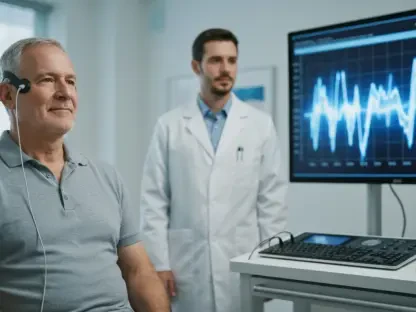The healthcare sector stands at a critical juncture, grappling with the mounting pressures of aging populations, escalating patient numbers, and persistent shortages of medical staff, all of which threaten to undermine the quality of care in hospitals and care facilities worldwide. Amid these challenges, a transformative solution is emerging through the integration of healthcare robots—sophisticated, mobile systems designed not to replace doctors or nurses, but to support their efforts by taking on repetitive, physically demanding, or hazardous tasks. These machines have the potential to alleviate burdens on healthcare workers, streamline operations, and preserve the irreplaceable human connection at the core of caregiving. This exploration delves into the profound impact of robotics on patient and staff support, shedding light on their diverse applications, market growth, technological advancements, and the hurdles that must be overcome for broader adoption.
Envision a hospital where nurses are relieved from the grueling task of lifting heavy patients, or corridors where robots autonomously shuttle medications and supplies to various wards. Healthcare robots are stepping into roles that address systemic strains, offering relief from workplace injuries that plague staff and reducing exposure to infectious diseases, a concern amplified during crises like the COVID-19 pandemic. By automating such tasks, these machines enable medical professionals to dedicate more time to delivering clinical expertise and emotional support, areas where human judgment and empathy remain paramount. The promise of this technology lies in its ability to enhance safety and efficiency without diminishing the personal touch that defines quality care.
The scope of these robots is impressively broad, tailored to meet a variety of needs within healthcare environments. Some are designed to assist with patient mobility, facilitating transfers and rehabilitation while safeguarding both patient dignity and caregiver health. Delivery robots traverse hospital floors, transporting meals, medicines, and equipment to save valuable time for staff. Disinfection robots employ UV-C light or chemical sprays to sanitize spaces, protecting workers from pathogens. Meanwhile, telepresence and social robots bridge gaps by enabling remote consultations or alleviating loneliness in elder care settings. This diversity underscores how robotics can address multiple facets of healthcare challenges with precision and adaptability.
The Growing Impact of Healthcare Robotics
Market Expansion and Industry Trends
The market for healthcare robotics is experiencing a remarkable surge, with projections indicating it could surpass $15 billion in value within the next decade. This growth extends beyond surgical applications to emphasize support systems for logistics, mobility, and direct patient assistance. Leading companies such as ABB, Omron, and SoftBank Robotics, along with a wave of innovative startups, are fueling this expansion by focusing on specialized areas like elder care. Industry consensus holds that these robots are not poised to replace healthcare professionals but to work alongside them, forming a hybrid model where machines manage routine or risky tasks, and humans bring expertise and compassion to the forefront. This collaborative approach is reshaping how care facilities operate under growing demand.
Investment in this sector reflects a strategic shift toward integrated solutions that address systemic inefficiencies. Partnerships between technology providers and healthcare institutions are driving the development of robots tailored to specific operational needs, from supply chain automation to patient interaction. The emphasis on niche markets, such as support for aging populations, highlights an understanding of demographic trends that will continue to strain resources. As the market evolves, the focus remains on creating systems that complement human efforts, ensuring that technology serves as a tool for enhancement rather than a barrier to personalized care. This trajectory suggests a future where robotics becomes a cornerstone of sustainable healthcare delivery.
Technological Advancements and Future Potential
Innovations in artificial intelligence (AI) and machine vision are propelling healthcare robots to new heights of capability and flexibility. Upcoming systems are anticipated to be multi-functional, adept at handling diverse tasks such as delivering supplies, monitoring environmental cleanliness, and supporting remote communication—all within a single platform. This adaptability is crucial in the dynamic, fast-paced settings of hospitals and care homes, where needs can shift rapidly. The goal of these advancements is to create seamless interactions between technology and staff, ensuring that robots integrate smoothly into daily routines without disrupting the flow of care. Such progress points to a future where efficiency is maximized through intelligent automation.
Beyond current capabilities, the potential for these robots to evolve into even more sophisticated partners is immense. As AI continues to advance, robots could take on predictive roles, identifying potential issues like equipment shortages or infection risks before they escalate. Machine vision enhancements may enable finer navigation in crowded hospital spaces, reducing errors and improving safety. The vision driving these developments is a balanced ecosystem where technology and humanity coexist, with robots alleviating operational burdens while leaving the nuanced, empathetic aspects of care to human hands. This forward-looking perspective emphasizes adaptability as key to meeting future healthcare demands.
Challenges in Adoption and Ethical Considerations
Barriers to Implementation
Despite the transformative promise of healthcare robots, significant obstacles stand in the way of their widespread integration into medical settings. The high initial costs of acquiring and deploying these systems can be prohibitive for many hospitals and care facilities, particularly those operating under tight financial constraints. Budget limitations often force administrators to prioritize immediate needs over long-term technological investments, delaying adoption. Moreover, the complexity of embedding robots into existing workflows, which are deeply human-centric, presents logistical challenges. Ensuring that these machines operate without interrupting patient care or staff routines requires meticulous planning and customization, a process that demands both time and resources.
Another critical barrier lies in the need for comprehensive staff training to build familiarity and trust in robotic systems. Healthcare workers, often already stretched thin, must adapt to new tools while maintaining their focus on patient well-being. Resistance to change or concerns about reliability can hinder acceptance, underscoring the importance of user-friendly designs and robust support structures. Addressing these implementation challenges necessitates strategic approaches, including phased rollouts and partnerships with technology providers to offset costs. Only through such measures can the benefits of robotics be realized without straining the very systems they aim to support, paving the way for broader acceptance.
Ethical Dilemmas and Human Connection
The integration of robots into healthcare also raises profound ethical questions about the balance between automation and the personal touch that defines compassionate care. A primary concern is the risk of diminishing human interaction, as tasks like patient engagement or emotional support could be partially delegated to machines. While robots can assist with routine activities, they lack the capacity for genuine empathy, potentially leading to a sense of isolation among patients, especially in elder care where companionship is vital. Striking a balance where technology aids rather than replaces these interactions remains a critical challenge for developers and healthcare leaders alike.
Additionally, ethical considerations extend to issues of accountability and oversight in robotic operations. Determining responsibility in cases of malfunction or error—whether it lies with the manufacturer, the hospital, or the staff—poses complex dilemmas. Privacy concerns also emerge, particularly with robots equipped with cameras or data collection capabilities for telepresence or monitoring. Safeguarding patient information and ensuring transparency in how these systems function are essential to maintaining trust. Addressing these ethical dimensions requires ongoing dialogue among stakeholders to establish guidelines that prioritize human dignity and connection, ensuring that technology enhances rather than detracts from the essence of caregiving.
Path Forward with Balanced Integration
Looking back, the journey of healthcare robots reveals a landscape reshaped by their ability to address pressing challenges like staff shortages, workplace injuries, and infection risks that once burdened medical systems. Their diverse applications, from patient mobility support to environmental disinfection, demonstrate a capacity to revolutionize operational efficiency in hospitals and care homes. Market expansion and technological innovations underscore a commitment to progress, while partnerships forged between industry leaders and healthcare providers lay the groundwork for integrated, effective solutions. These efforts highlight a shared goal of enhancing care delivery through automation without losing sight of human needs.
Reflecting on the obstacles encountered, issues of cost, integration complexity, and ethical concerns prompt a reevaluation of how best to implement robotic systems. Moving forward, the focus should shift to actionable strategies such as securing funding through public-private collaborations to offset expenses, developing standardized training programs for staff, and establishing ethical frameworks to guide usage. Prioritizing pilot programs in varied settings can offer insights into scalable adoption, while continuous feedback from healthcare workers and patients can refine robotic roles. These steps aim to ensure that robots remain steadfast partners in a hybrid care model, ultimately fostering a safer, more humane approach to healthcare for future generations.









